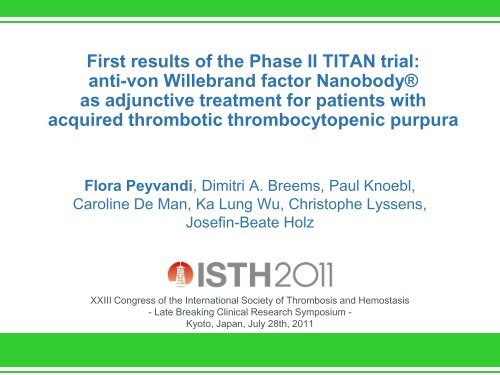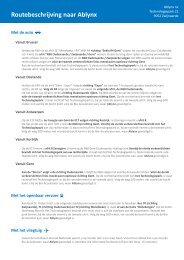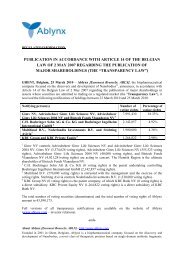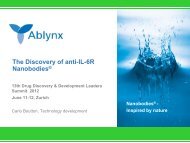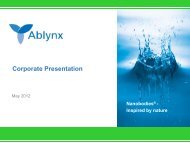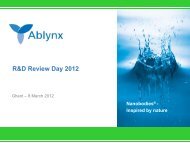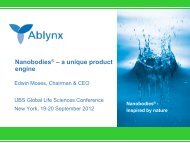First results of the Phase II TITAN trial: anti-von Willebrand ... - Ablynx
First results of the Phase II TITAN trial: anti-von Willebrand ... - Ablynx
First results of the Phase II TITAN trial: anti-von Willebrand ... - Ablynx
Create successful ePaper yourself
Turn your PDF publications into a flip-book with our unique Google optimized e-Paper software.
<strong>First</strong> <strong>results</strong> <strong>of</strong> <strong>the</strong> <strong>Phase</strong> <strong>II</strong> <strong>TITAN</strong> <strong>trial</strong>:<br />
<strong>anti</strong>-<strong>von</strong> <strong>Willebrand</strong> factor Nanobody®<br />
as adjunctive treatment for patients with<br />
acquired thrombotic thrombocytopenic purpura<br />
Flora Peyvandi, Dimitri A. Breems, Paul Knoebl,<br />
Caroline De Man, Ka Lung Wu, Christophe Lyssens,<br />
Josefin-Beate Holz<br />
Nanobodies ® -<br />
Inspired by nature<br />
XX<strong>II</strong>I Congress <strong>of</strong> <strong>the</strong> International Society <strong>of</strong> Thrombosis and Hemostasis<br />
- Late Breaking Clinical Research Symposium -<br />
Kyoto, Japan, July 28th, 2011
TTP: thrombotic thrombocytopenic purpura<br />
• Is an acute life threatening disorder, characterised by:<br />
– microangiopathic haemolytic anaemia<br />
– thrombocytopaenia<br />
– microvascular thrombosis that causes variable degree <strong>of</strong> tissue ischaemia<br />
and infarction<br />
• Rare: 5-11 cases per million people per year<br />
• PE (plasma exchange) decreased mortality from 90% to 10%<br />
• M:F ratio = 1:3<br />
• 5% congenital and 95% acquired<br />
• 20-30% risk <strong>of</strong> recurrence<br />
2
Clinical symptoms at <strong>the</strong> first three episodes<br />
• 33 patients with 3 or more disease episodes<br />
p
Classification <strong>of</strong> TTP<br />
Congenital<br />
5%<br />
Acquired<br />
95%<br />
Secondary<br />
50%<br />
Idiopathic<br />
(autoimmune)<br />
50%<br />
• Drugs<br />
• Autoimmune<br />
disease<br />
• Infections and HIV<br />
• Tumours<br />
• Pregnancy<br />
4
ADAMTS13<br />
• VWF cleaving protease (ADAMTS13) cleaves<br />
ULVWF as soon as <strong>the</strong>se molecules are released<br />
by injured or activated endo<strong>the</strong>lial cells<br />
• The importance <strong>of</strong> VWF regulation by ADAMTS13<br />
is demonstrated by <strong>the</strong> close association between<br />
severe deficiency <strong>of</strong> ADAMTS13 activity and<br />
clinical TTP<br />
5
Rationale <strong>of</strong> TTP <strong>the</strong>rapy<br />
Congenital TTP Acquired TTP<br />
Supply ADAMTS13<br />
Remove <strong>the</strong> ULVWF<br />
and <strong>anti</strong>-ADAMTS13 Ab<br />
Supply ADAMTS13<br />
Plasma infusion PE<br />
Reduce<br />
<strong>anti</strong>-ADAMTS13 Ab<br />
production<br />
Steroids<br />
Immunosuppressives<br />
6
Treatment <strong>of</strong> acute TTP<br />
• Survival <strong>of</strong> patients with TTP<br />
Rock et al, NEJM 1991<br />
7
Major complications <strong>of</strong> PE<br />
• Experience <strong>of</strong> <strong>the</strong> Oklahoma TTP-HUS registry, 1996-2008<br />
% <strong>of</strong> patients<br />
14<br />
12<br />
10<br />
8<br />
6<br />
4<br />
2<br />
0<br />
3<br />
Death Non fatal<br />
cardiac arrest<br />
1<br />
2<br />
Ca<strong>the</strong>ter<br />
insertion<br />
complications<br />
12<br />
Systemic<br />
infection<br />
7<br />
Ca<strong>the</strong>ter<br />
obstruction<br />
3<br />
Hypotension Venous<br />
thrombosis<br />
2<br />
George et al, Blood 2010<br />
8
Immunosuppressive agents<br />
• Corticosteroids<br />
– <strong>the</strong> use <strong>of</strong> glucocorticoids is based only on clinical experience and case<br />
series<br />
(Vesely et al Blood 2003, Perotti et al Haematologica 1996, Coppo et al BJH 2006, Cataland et al BJH 2007)<br />
– in combination with PE increased complete remission rate and decreased<br />
exacerbation and relapse rates<br />
(Vesely et al Blood 2003, Coppo et al BJH 2006, Cataland et al BJH 2007, Baduini et al Ann Hematol 2010)<br />
• Rituximab<br />
– 95% had a complete clinical and laboratory response within 1-3 weeks<br />
– mild acute reactions to rituximab infusions easily managed<br />
– more serious complications were uncommon<br />
– number <strong>of</strong> PE to remission, inpatient stay and relapse rate reduced<br />
(Gutterman LA et al Blood Cells Mol Dis 2002, Galbusera M et al Blood 2005, Herbei L & Venugopal P Clin<br />
Adv Hematol Oncol 2006, Scully M et al BJH 2007, Heidel F et al TH 2007, Patino W & Sarode R J Clin Apher<br />
2007, Scully M et al BJH 2008, Bresin E et al TH 2009, Scully M et al Blood 2011)<br />
9
Treatment outcome<br />
• Disease duration is variable<br />
• The clinical response is usually achieved after 9-16 days <strong>of</strong> plasma<br />
<strong>the</strong>rapy<br />
• Mortality reduced to 10-20% with PE, but still high<br />
• Mortality is highest in <strong>the</strong> first days from disease onset<br />
• Exacerbation: new clinical signs and symptoms within 30 days after<br />
normalisation <strong>of</strong> platelet count (25-50%)<br />
• Relapse: new clinical sign and symptoms more than 30 days after<br />
normalisation <strong>of</strong> platelet count (20-30%)<br />
(Rose M et al Am J Med 1987, Rock GA et al NEJM 1991, Bell WR et al NEJM 1991, Onundarson PT et al Ann<br />
Intern Med 1992, Thompson CE et al Blood 1992, Hayward CP et al Arch Intern Med 1994, Sarode R et al Am J<br />
Hematol 1997, Lara PN Jr et al Am J Hematol 1999, Burns ER et al Am J Hematol 2004, Zheng Xl et al Blood<br />
2004, Scully M et al BJH 2006, Sadler JE Blood 2008)<br />
10
Perspectives<br />
• Recombinant ADAMTS13 (Baxter)<br />
• Anti VWF-GPIb agents:<br />
─ ARC-1779 aptamer (Archemix - Baxter)<br />
─ ALX-0081 Nanobody (<strong>Ablynx</strong>)<br />
─ rGPG 290 (Aar<strong>von</strong> Biosciences)<br />
• Novel <strong>anti</strong>-CD20 products (LFB, Roche etc)<br />
11
Anti-VWF Nanobody (ALX-0081/ALX-0681)<br />
• Bivalent 28 kD Nanobody<br />
– new mode <strong>of</strong> action<br />
– stops platelet adhesion to vessel wall at<br />
high blood flow<br />
• Positive preclinical data<br />
– potent inhibition <strong>of</strong> clotting without<br />
increasing bleeding potential<br />
– in vitro inhibition <strong>of</strong> platelet adhesion to<br />
ULVWF and <strong>of</strong> platelet string formation<br />
• Potential clinical benefits<br />
– improved efficacy and safety as adjunct<br />
to plasma exchange<br />
Camelidae family has both forms<br />
C H2<br />
C H3<br />
CH1 CL Conventional<br />
<strong>anti</strong>body<br />
Bivalent<br />
<strong>anti</strong>-VWF<br />
Nanobody<br />
V H<br />
V L<br />
C H2<br />
C H3<br />
V HH<br />
Heavy-chain<br />
<strong>anti</strong>body<br />
V HH<br />
<strong>Ablynx</strong>’s<br />
Nanobody<br />
Anti-VWF<br />
Nanobody<br />
Structure : courtesy <strong>of</strong> Steyaert et al, VUB<br />
12
ALX-0081: mode <strong>of</strong> action in TTP<br />
• Endo<strong>the</strong>lial cells release ULVWF multimers, which are unfolded by shear stress<br />
and subsequently processed by ADAMTS13 into smaller multimers<br />
• Normal VWF multimers require conformational activation for platelet interaction<br />
• In TTP, ADAMTS13 is dysfunctional and ULVWF becomes<br />
activated allowing <strong>the</strong> formation <strong>of</strong> unwanted platelet<br />
aggregates.<br />
Shear stress<br />
Release <strong>of</strong> UL-VWF<br />
Endo<strong>the</strong>lium<br />
Subendo<strong>the</strong>lium<br />
Conformational<br />
change<br />
Persistence <strong>of</strong><br />
UL-vWF multimers<br />
Anti-VWF<br />
Nanobody<br />
Platelet string formation<br />
13
ALX-0081 binds <strong>the</strong> N-terminus <strong>of</strong> <strong>the</strong> VWF A1-domain<br />
A1-vWF<br />
C<br />
N<br />
GPIbα<br />
Monovalent building<br />
block <strong>of</strong> ALX-0081<br />
PDB 1M10 (complexed A1-VWF)<br />
<strong>Ablynx</strong> A1-VWF-Nb structure<br />
CDR2<br />
CDR3<br />
N<br />
CDR1<br />
C<br />
14
ALX-0081 potently neutralises ULVWF in vitro<br />
• Effective concentrations linked with VWF:Ag levels<br />
Ex vivo platelet string formation<br />
ULvWF<br />
ULvWF and <strong>anti</strong>-vWF Nanobody<br />
Anti-vWF Nanobody inhibits platelet string formation caused by<br />
ULvWF in plasma <strong>of</strong> TTP patients<br />
15
Clinical studies with ALX-0081 related to TTP indication<br />
<strong>Phase</strong> Population n Regimen/dose Status<br />
I<br />
Healthy<br />
volunteers<br />
I Healthy<br />
volunteers<br />
<strong>II</strong><br />
Patients with<br />
acquired<br />
TTP<br />
• Clinical status<br />
40<br />
36<br />
110<br />
– <strong>Phase</strong> I <strong>trial</strong>s successfully completed, up to 14d treatment well tolerated, no<br />
immunogenicity (limited exposure), mild bleeding and bruising, partial decrease <strong>of</strong><br />
VWF:Ag and FV<strong>II</strong>I activity levels<br />
Single dose<br />
i.v. infusion<br />
0.5-12 mg<br />
Single and multiple dose<br />
s.c.<br />
2–16 mg and 10 mg (7-14 d)<br />
Multiple doses<br />
i.v. and s.c.<br />
10-20 mg/d as adjunct to PE<br />
– <strong>Phase</strong> <strong>II</strong> (acquired TTP) primary endpoint: time-to-platelet recovery<br />
Completed – final<br />
study report<br />
Completed - final<br />
study report<br />
Ongoing<br />
16
The <strong>TITAN</strong> <strong>trial</strong>: study design<br />
Inclusion criteria<br />
• men and women<br />
• 18 years or older<br />
• clinical diagnosis <strong>of</strong> TTP,<br />
necessitating PE<br />
Exclusion criteria<br />
• platelet count ≥ 100,000/µL<br />
• severe active infection<br />
indicated by sepsis<br />
• infection with E. coli 0157 or<br />
related organism<br />
• <strong>anti</strong>-phospholipid syndrome,<br />
DIC or congenital TTP<br />
• pregnancy or breast-feeding<br />
• active bleeding or high risk<br />
<strong>of</strong> bleeding<br />
• uncontrolled arterial<br />
hypertension<br />
• chronic <strong>anti</strong>coagulant<br />
treatment<br />
• bone marrow carcinosis<br />
• severe liver impairment<br />
Randomisation<br />
1:1<br />
n = 110<br />
PE<br />
PE<br />
Primary endpoint<br />
time-to-response,<br />
Placebo<br />
<strong>anti</strong>-VWF Nanobody<br />
defined by recovery <strong>of</strong><br />
platelets ≥ 150,000/µL<br />
and confirmation at 48 h by<br />
de novo measure <strong>of</strong><br />
platelet count ≥ 150,000/µL<br />
and LDH ≤ 2 x ULN<br />
30 days<br />
30 days<br />
1 year follow-up<br />
1 year follow-up<br />
Secondary endpoints<br />
• PE frequency and volume<br />
• relapse<br />
• exacerbations<br />
• mortality<br />
• major clinical events<br />
• recovery from signs and<br />
symptoms<br />
17
1:1<br />
Study treatment and schedule<br />
Recruitment<br />
Randomisation<br />
ALX-0081<br />
Placebo<br />
Prior to<br />
first PE<br />
single<br />
i.v. bolus<br />
(10 mg)<br />
Treatment phase<br />
PE period<br />
s.c. doses<br />
(10 mg)<br />
1 or 2/day<br />
based on RiCo<br />
assay<br />
Post-PE<br />
(30 days)<br />
s.c. doses<br />
(10 mg)<br />
1 or 2/day<br />
based on RiCo<br />
assay<br />
Follow-up<br />
(1 year)<br />
Primary endpoint Secondary endpoints<br />
18
Nanobodies ® -<br />
Inspired by nature
PD measurement<br />
• RICO/RIPA assay as only suitable assay to assess specifically full<br />
neutralisation <strong>of</strong> (UL)VWF by ALX-0081<br />
Assay Test principle Pro Con<br />
RIPA<br />
RICO<br />
vWF:Act<br />
PFA-100<br />
VWF-mediated aggregation<br />
<strong>of</strong> autologous platelets by<br />
ristocetin<br />
VWF-mediated aggregation<br />
<strong>of</strong> fixed platelets by<br />
ristocetin<br />
Immunoassay with mAb<br />
that interacts with GPIbbinding<br />
region in VWF<br />
High shear flow system to<br />
measure platelet adhesion<br />
and aggregation upon<br />
stimulus<br />
Correlates with preclinical<br />
efficacy <strong>of</strong> ALX-0081 (ACS)<br />
• Demonstrated equivalence<br />
to RIPA<br />
• Can be performed on<br />
frozen samples<br />
Easy, high throughput<br />
• Requires specific<br />
equipment<br />
• Low throughput<br />
• Fresh samples<br />
• Requires specific<br />
equipment<br />
• Low throughput<br />
No inhibition <strong>of</strong> response by<br />
ALX-0081<br />
Easy, high throughput Aspecific: interference <strong>of</strong><br />
comedication<br />
20
Demographic and baseline characteristics (1)<br />
• 2 men and 3 women<br />
• 3 on Nanobody treament, 2 on placebo<br />
• 4 with first episode <strong>of</strong> TTP, 1 with recurrent TTP<br />
• clinical symptoms at presentation:<br />
– 10 neurological<br />
– 4 purpura + o<strong>the</strong>r cutaneous bleeding manifestations<br />
– 2 non-cutaneous bleeding<br />
– 2 gastrointestinal<br />
– 2 cardiovascular<br />
– 1 o<strong>the</strong>r<br />
21
Demographic and baseline characteristics (2)<br />
Parameter n Mean (SD) Min-max<br />
Age (years) 5 46 (12) 31-60<br />
Weight (kg) 5 85 (30) 52-118<br />
BMI (kg/m²) 5 31,3 (9,7) 20-45<br />
Platelet count (10 9 /L) 5 27 (15) 7-41<br />
LDH (U/L) 5 1646 (880) 909-2795<br />
RICO (%) 5 95 (35) 41-120<br />
vWF:Ag (%) 5 233 (126) 114-420<br />
Nanobodies ® FV<strong>II</strong>I:C (%) 5 197 (89) 76-315 -<br />
ADAMTS13 (CBA) (%) 4 39 (38) Inspired by
PE details<br />
• PE treatment<br />
– variable duration <strong>of</strong> PE treatment: 5-23 days<br />
– type <strong>of</strong> plasma used: fresh frozen plasma, Octoplas BG A or VPVI<br />
methylene blue<br />
– volume <strong>of</strong> plasma administered: 2500-4400 mL<br />
• Use <strong>of</strong> concomitant glucocorticoids or o<strong>the</strong>r immunosuppressants<br />
– methylprednisone: 5/5 subjects<br />
– rituximab: 1/5 subjects<br />
23
Preliminary observations: platelet count (n = 5/110)<br />
24
Preliminary observations: RiCo (n = 5/110)<br />
Normal range<br />
25
Preliminary observations: VWF:Ag (n = 5/110)<br />
Normal range<br />
26
Preliminary observations: FV<strong>II</strong>I acitivity (n = 5/110)<br />
27
Normal range<br />
Preliminary observations: ADAMTS13 (n = 5/110)<br />
Normal range<br />
Nanobodies ® -<br />
Inspired by nature<br />
28
Preliminary observations: <strong>anti</strong>-ADAMTS13 Abs (n = 5/110)<br />
Normal range<br />
Nanobodies ® -<br />
Inspired by nature<br />
29
Preliminary observations: ULVWF ratio (n = 5/110)<br />
Normal range<br />
30
Serious adverse events<br />
• 2 SAEs reported in 2/5 subjects during treatment phase:<br />
– metrorrhagia with severe anaemia<br />
o1 subject in perimenopausal period<br />
oresolved<br />
ostudy drug discontinued, subject withdrew consent<br />
oconsidered possibly related to study drug by <strong>the</strong> Investigator → but in<br />
perimenopausal age, <strong>the</strong> most common cause <strong>of</strong> abnormal vaginal bleeding<br />
is anovulation (Nesse RE, Am Fam Physician 1999, James A et al. Eur J Obstet Gynecol Reprod Biol<br />
2011)<br />
– Urinary tract infection<br />
o1 subject<br />
oresulting in hospitalisation<br />
oresolved<br />
oconsidered unlikely/not related to study drug by <strong>the</strong> Investigator<br />
31
Conclusions<br />
• ALX-0081 in combination with PE is under clinical investigation as a<br />
novel <strong>the</strong>rapeutic approach to reduce <strong>the</strong> days <strong>of</strong> PE <strong>the</strong>rapy and<br />
accelerate <strong>the</strong> recovery <strong>of</strong> TTP patients<br />
• The current <strong>Phase</strong> <strong>II</strong> <strong>trial</strong> is designed to assess <strong>the</strong> efficacy and<br />
safety <strong>of</strong> ALX-0081 in TTP patients, in particular to characterise<br />
potential bleeding risk <strong>of</strong> temporary, ‘<strong>the</strong>rapeutic’ suppression <strong>of</strong><br />
VWF-mediated platelet aggregation<br />
32
Acknowledgements<br />
• Hemophilia and Thrombosis Center, Fondazione IRCCS<br />
Ca’ Granda, Ospedale Maggiore Policlinico, Milan, Italy<br />
– Roberta Palla<br />
– Maria Teresa Bajetta<br />
– Luciano Baronciani<br />
– Giuseppe Bettoni<br />
– Maria Teresa Canciani<br />
– Silvia La Marca<br />
– Ilaria Mancini<br />
– Silvia Pontiggia<br />
– Francesca Stufano<br />
– Carla Valsecchi<br />
• Hospital Network Antwerp, campus Stuivenberg, Belgium<br />
– Dimitri Breems<br />
– Caroline De Man<br />
– Ka Lung Wu<br />
• Medical University <strong>of</strong> Vienna, Austria<br />
– Paul Knoebl<br />
• University College London Hospitals, UK<br />
– Sam Machin<br />
– Marie Scully<br />
– Ian Mackie<br />
• <strong>Ablynx</strong><br />
• CROs:<br />
– Bernard Delaey<br />
– Christophe Lyssens<br />
– Christian Duby<br />
– Dominique Tersago<br />
– Femke Van Bockstaele<br />
– Hans Ulrichts<br />
– Josi Holz<br />
– Katrien Verschueren<br />
– I3 research<br />
– PRA international<br />
33


